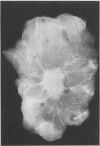Abstract
AIM--To investigate histologically the power of specimen slice radiography to record invasive and in situ carcinoma in breast conserving cancer excisions. METHODS--Twenty six cancer excisions were converted into 171 complete tissue slices, which were examined radiographically. From these slices, 373 histological blocks were processed and histological and radiographic assessments were compared. RESULTS--Radiography and histology mapped excision margins and lesions in detail. Radiographic prediction of histology was imprecise. Six invasive carcinomas were either undetectable by radiology or reached a radiologically clear margin. Six small invasive carcinoma satellites were not recognised. Adjacent ductal carcinoma in situ was undetectable in nine of 15 cases. CONCLUSIONS--Slice radiography and histology are capable of precise lesion mapping in breast cancer excisions, and clinical utility of such mapping merits investigation. Radiology alone is imprecise and to infer complete excision of breast carcinoma by radiography (of excision specimens or residual breast) alone may be unsafe.
Full text
PDF


Images in this article
Selected References
These references are in PubMed. This may not be the complete list of references from this article.
- Abernathy C. M., Hedegaard H., Weger N. Screening for breast cancer detects tumours at an earlier biological stage. Br J Surg. 1994 Jun;81(6):922–922. doi: 10.1002/bjs.1800810647. [DOI] [PubMed] [Google Scholar]
- Connolly J. L., Schnitt S. J. Evaluation of breast biopsy specimens in patients considered for treatment by conservative surgery and radiation therapy for early breast cancer. Pathol Annu. 1988;23(Pt 1):1–23. [PubMed] [Google Scholar]
- England D. W., Chan S. Y., Stonelake P. S., Lee M. J. Assessment of excision margins following wide local excision for breast carcinoma using specimen scrape cytology and tumour bed biopsy. Eur J Surg Oncol. 1994 Aug;20(4):425–429. [PubMed] [Google Scholar]
- Holland R., Hendriks J. H., Vebeek A. L., Mravunac M., Schuurmans Stekhoven J. H. Extent, distribution, and mammographic/histological correlations of breast ductal carcinoma in situ. Lancet. 1990 Mar 3;335(8688):519–522. doi: 10.1016/0140-6736(90)90747-s. [DOI] [PubMed] [Google Scholar]
- Holland R., Veling S. H., Mravunac M., Hendriks J. H. Histologic multifocality of Tis, T1-2 breast carcinomas. Implications for clinical trials of breast-conserving surgery. Cancer. 1985 Sep 1;56(5):979–990. doi: 10.1002/1097-0142(19850901)56:5<979::aid-cncr2820560502>3.0.co;2-n. [DOI] [PubMed] [Google Scholar]
- Macmillan R. D., Purushotham A. D., Mallon E., Ramsay G., George W. D. Breast-conserving surgery and tumour bed positivity in patients with breast cancer. Br J Surg. 1994 Jan;81(1):56–58. doi: 10.1002/bjs.1800810119. [DOI] [PubMed] [Google Scholar]
- Recht A., van Dongen J. A., Peterse J. L. Ductal carcinoma in situ. Lancet. 1994 Apr 16;343(8903):969–969. doi: 10.1016/s0140-6736(94)90085-x. [DOI] [PubMed] [Google Scholar]
- Umpleby H. C., Herbert A., Royle G. T., Taylor I. Wide excision of primary breast cancer: the incidence of residual carcinoma at the site of excision. Ann R Coll Surg Engl. 1988 Jul;70(4):246–248. [PMC free article] [PubMed] [Google Scholar]




